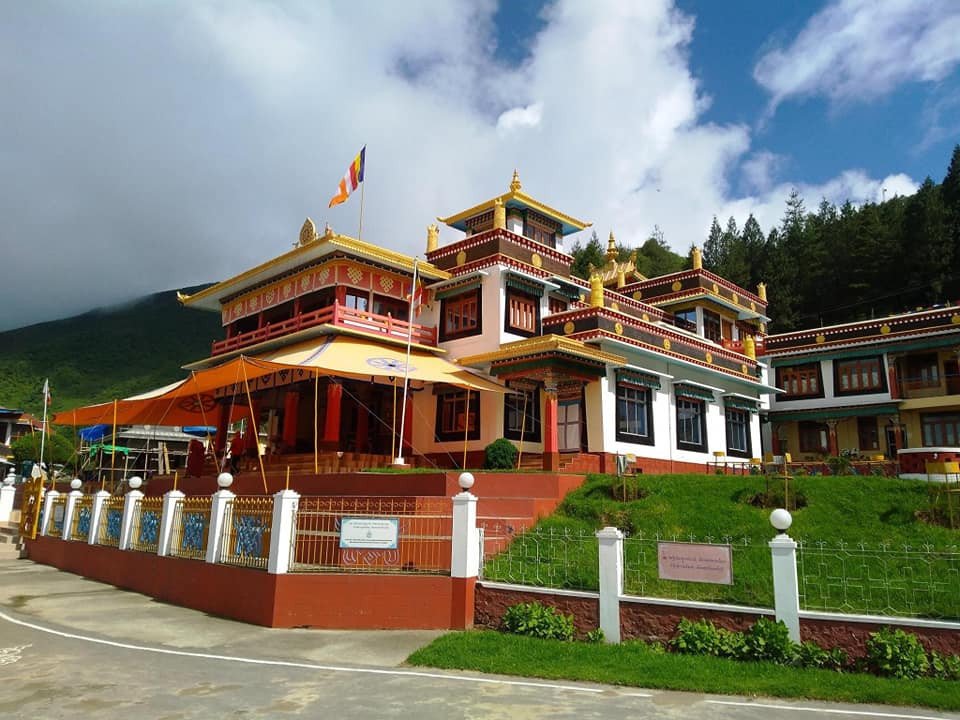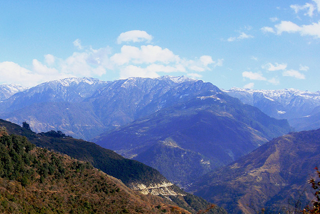Bomdila is located at 27.25°N 92.4°E. It has an average elevation of 2217 metres (7273 feet). It is 109 km from Bhalukpong and is the headquarters of West Kameng District. The place is inhabited by tribes like Aka (Hrusso), Miji (Sajalong), Monpa, Sherdukpen, and Khawas. The craft centers, monasteries, ethnographic museum and emporium etc. are worth visiting. One can also watch various snow clad mountain peaks from Bomdila including the Kangto and Gorichen Peaks which are the highest peak of the state. With snow clad Himalayan mountain ranges and lush greenery to flaunt its natural beauty and various crafts to boast of its rich culture and lifestyle, Bomdila ranks amongst the leading tourist destinations in Arunachal Pradesh. Bomdila is a photographer’s delight, as the snow-capped mountain ranges of Himalayas offer spectacular views. To enjoy the essence of nature in its varied forms, you could not think of a better place than Bomdila.
Bomdila Monastery was established in the year 1965 and it represents the spiritual essence of Buddhism. It is situated close to Tipi Orchid Research Center in West Kameng district. Followers of Mahayana Buddhism consider this place sacred. The monastery resembles Tsona Gontse Monastery of South Tibet. The temple of Buddha in the monastery attracts pilgrims in great numbers.
Lying on a hill, Upper Gompa attracts tourist in great numbers, as it is a symbol of the traditions associated with Buddhism. It is also called as Gentse Gaden Rabgyel Ling (GRL) Monastery. A school to educate monk kids is in Upper Gompa. A temple of Buddha and a prayer hall are seen here. The wall hangings in the prayer hall are reflection of the culture. Lower Gompa is located at the center of Bomdila. The influence of Tibetan architecture is prominent in Lower Gompa. Lower Gompa has a huge sized prayer hall. Followers of Buddhist philosophy do not miss visiting the place as they consider it sacred. Middle Gompa is situated close to the main market in Bomdila. Middle Gompa is one amongst the oldest gompas. This Gompa is popular amongst healers as the Blue Medicine Buddha in the Gompa is focused by healers as they pray and meditate.
Craft Center and Ethnographic Museum is precisely where you need to be if you want to experience the essence of the culture and lifestyle of Bomdila. The hand woven carpets, traditional masks and wall hangings are uniquely designed. Carpets with dragon designs are very famous here. This is also the place from where you could buy craft items to take back with you as souvenirs.
Bomdila is famous for apple orchards. They are spread across large areas of the land. Laden with apples, the huge trees in the orchards are great attractions to tourists. Visiting Bomdila in winter would be a feast to your eyes as apple orchards will be at their optimum best in production. You are sure to love the casual stroll in the apple orchards and the temptation to buy apples for unbelievably low prices is too hard to resist.
Nature lovers will love Bomdila View Point, as views from here are spectacular. The highest point here offers breathtaking views of the landscape around including Nechipu Pass. West Kameng Valley spreads out in front of your eyes when viewed from here.
R.R. Hill is yet another important tourist attraction being Bomdila’s highest point. Apart from the scenic landscape that is the specialty of Bomdila, you could also view the road that leads to Tawang and to Bhutan’s border.
Essentials
The Gontse Gaden Rabgyel Ling monastery, also famous as the GRL Monastery, houses Buddhist Lamas and monks at Bomdila. It is also recognized as one of the major centers of the Lamaistic faith of Mahayana Buddhism. The GRL monastery is situated in the Western Kameng District of Arunachal Pradesh and was built by the 12th reincarnate of Tsona Gontse Rinpoche in 1965–66.
The main Gompa has three divisions, namely, the Lower Gompa, the Middle Gompa, and the Upper Gompa. The Upper Gompa is considered to be the main monastery. While the Lower Gompa is situated at the end of the main market area, depicting the richness of Tibetan architecture, the Middle Gompa can be found at about 2 km from the main market. There is a vast prayer hall inside the Lower Gompa. Popular belief says that ringing the bell of the Gompa fulfills one’s wishes.
At the Middle Gompa, there is the Blue Medicine Buddha, which is also known as the Lord of Medications, as this deity is believed to cure diseases, by the locals. People perform prayers and meditation to undergo healing. The Middle Gompa is the oldest of all three gompas.
Apart from the Lower and the Middle Gompas, the GRL Monastery also has the Upper Gompa which is the main part of the monastery. It houses a school for the monk’s children, along with a prayer hall and a buddha temple. The Upper gompa has proven to be a major tourist attraction over the years for its peaceful Buddhist preachings.
As this Gompa comprises of a vibrant building surrounded by a serene atmosphere, it gives the visitors unmatched peace of mind. This Gompa is said to be a replica of the Tsona Gontse monastery at Tsona of southern Tibet. There is a prayer hall in the GRL monastery where the Lamas and the monks offer prayers. The Lamas live at residential quarters which is located near the main gompa. The senior Lamas of the monastery engage in educating the younger Lamas about the Tantrayana practices and the monastic way of life.



The District Craft centre & Ethnographic Museum at Bomdila, is a center that produces fine carpets of colorful designs and masks. Visitors coming to Bomdila make sure not to miss the museum.
A variety of carpets, Buddhist Thangkas (wall hangings) and handicrafts along with masks are produced and displayed here. The dragon design carpets are the major attraction of the museum.
Bomdila View Point provides magnanimous view of entire West Kameng Valley. From the highest point of this place, tourists can also enjoy beautiful views of clouds congregated at the top of the Nechipu Pass.
Thembang village, located at about 2300m altitude is of high historical and cultural significance. Thembang is located approximately 55km north-east of Bomdila township at the altitude of 2169 m. above MSL. under the Thembang administrative circle in West Kameng district of Arunachal Pradesh. The area falls to the east of Tawang-Bomdila road and about 14 km far away from Munna camp. Thembang village and Dzong are surrounded with the majestic beauty of lush green hills, steep gorges and snow clad peaks. The River Dirang cascades down the gorge running along the western side of Thembang gorge in the South-East direction. It is an ancient village. In medieval era it was a headquarter of a large territory which was ruled by the powerful Thembang Bapu who were the direct descendant of the king of Tibet. This is a one of the oldest village in the region and it has witnessed many wars as a result a strong fortification with two stone wall gates (Northern and southern gate) were made by the villagers of Rahung, Khutam, Bhud and Khowna who were under the sovereignty of the Bapus during that time. A loud shout was given as a warning every evening before closing the giant gates. In 1913 Lt. Col. F M Bailey and Capt. H T Morshead of the Survey of British India have stayed here while coming down from Tibet during their Tsangpo Exploration in 1912-13 which is now known as Bailey trail. Many British officers including H W Tilman in 1938 had stayed in Thembang. The village has also witnessed a fierce battle between Indian and Chinese armies during the 1962 Indo-China war. A huge Chinese army had come down here through the Bailey trail went straight to Bomdila after securing Thembang, encircling a large numbers of Indian army between Bomdila and Sela Pass.
The Thembang fort (Dzong) has two gates — one at northern side and the other at the southern side of village fortification. The northern gate measures 3.50 m. X 5.00 m while the gate at the southern side is in the nature of an emergency or escape gate. The construction of the Dzong and the gates follows traditional construction systems of the Monpas, which includes composite stone masonry and wood architecture. Ornamental features include carved stone blocks, mani walls (stone walls with prayers engraved on them), traditional wood carvings, paintings and manuscripts, etched as murals and graffiti along the houses and ancient ruins. The Dzong area is inhabited by the Thembang Bapu of the Monpas since many generations. Due to increase of their population, a section of the Thembang Bapu is also settled outside the old Thembang Dzong. There are 42 households in the village and the total population is 250. Most of the dwellings are made in traditional method of indigenous Monpa architecture. Thembang Dzong was also constructed using same traditional architecture which is still prevalent.
Pre-historic archaeological evidence has also been excavated by the Archaeological Section of the Research Department, Govt. of Arunachal Pradesh at Thembang. Some of the items recovered include Neolithic Celt, various Neolithic tools, Stone Age axe etc.
The predominant religion at Thembang is Buddhism and ownership of properties at Thembang is not individual based but controlled by the local panchayat and deemed as community ownership.The area adjacent to Thembang is rich with biodiversity and a wide variety of wild animals, including rare species such as Red Panda, are found in these forests. The locals of Thembang respect this ecological richness and have incorporated its aspects in their socio-religious practices. The Monpas knows to maintain the ecological equilibrium as part of their socio-cultural life. The area is also homeland of different species of herbs and orchids which have medicinal value. They are having the sound knowledge in practice of ethno medicine as part of their traditional wisdom.
As the village is located on a hill top, one can enjoy the view of Dirang River that meanders down below and mountain ranges of different colours. As there has been very little impact of urbanisation in the village, it provides immense potential to experience the traditional life style and culture of Monpa indigenous tribal community. Wide altitude range (2000m to above 6000m) provides natural advantage for nature loving tourist to fill the experiences inside forest types ranging from Temperate to Alpine Meadows and enjoy views of state’s highest peak ‘Gorichen’. The area also provide opportunity to nature lovers to see rare flora like Orchids, Rhododendrons, Primula and medicinal plants and fauna like Red Panda, Musk Deer, Himalayan Black Bear, Blue Sheep, Takin etc. Rich diversity of birds, which includes, Blood Pheasant, Monal, Tragopan etc. make the area one of the dream destination for bird watchers.
There is an old Monastery in which traditional wood carving, paintings and manuscripts have been preserved carefully. The ruins of fortification of the village can be seen with two stone wall gates in the two sides of the village. There are many caves of religious significance in and around village there are numerous stone blocks with carvings on them. In the village one has option to experience traditional village life style, agriculture system, animal rearing, traditional food, traditional dance and cultural programs. As the village is located on hill top, from the village one can enjoy the view of the Dirang River flowing down below, roads from Bomdila to Dirang and ranges of mountains of different colour.




